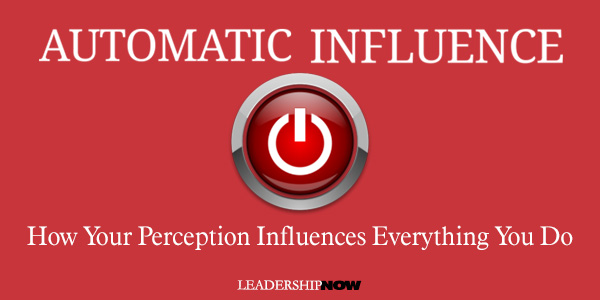 |
 |
03.24.23

Automatic Influence: How Your Perception Influences Everything You Do
IT ALL STARTS with perception. Everything we feel, every choice we make, and everything we do all starts with our perception of our environment. Our perceptions automatically influence our feeling, and they in turn, automatically influence our actions. Perception is powerful. Erik Van Alstine takes us through the various ways the See-Feel-Act Progression influences everything we do in Automatic Influence: New Power for Change in Work and Life.
When trying to change, we need to get to the root of the problem—our perception. “Change is hard. But when we change the way we see, we strike at the root, automatically influencing emotion and behavior.” The secret to automatic influence is to start with perception. Perception is the power button. One click changes emotion, behaviors and, ultimately, the outcome of our lives. At the same time, our perception is a bit unruly. Our perceptions are prone to error. It isn’t as straightforward as just seeing. “Perception is a combination of feeds from reality and imagination” —our inner and outer worlds. We just think we are seeing things as they really are. When we see wrong, we feel wrong, and then we act wrong.
When we start seeing how blind we are, it changes things. We take time to listen, to clarify, to understand. We don’t just listen to be polite. We listen because we want to. We know that we’re making assumptions and mistaking them for facts, and without double-checks and outside help, we’ll make critical mistakes. As leaders, we need to love and care for those we steward—especially those who are different from us. Our perception of others is what triggers that feeling and behavior in us. What triggers love? “Seeing people are people, of equal value and with equal needs as ourselves. Love is the automatic response to seeing people right. When we see people as they are, we feel love and are motivated to serve people instead of using people or ignore people.” We naturally seek the maximum good in our lives. That is, the best we can have given the circumstances we perceive. That leaves us wide open to do bad. For the most part, evil leaders—bad characters—are doing what seems right to them based on the reality they see. We all pursue the maximum good as we see it. “It means people can see wrong and feel wrong and act wrong in response, all the while believing they are seeing right, feeling right, and doing right.” Doing wrong can feel right. We deceive ourselves. Our choices and our need to justify those choices create biases. The long-term effect of that is that we “carry those biases forward to the next situation. Years later, that bias might still be guiding us. Which means there could be hundreds of bad beliefs boxed up in the basement of our minds, distorting the way we see and creating automatic evil.” What do we do? We need to carefully manage our attention. Stay focused on the right things. Widen our perception through constructive feedback. Our minds filter what we see. We don’t see everything. There is our perceived reality and our ignored reality. As a result, “there’s a really good chance that we’re seeing the wrong things, that our way of seeing is sabotaging our highest and best, because we don’t have the right information.” Or we choose to ignore it. Another way is to abandon happiness as a goal in our life. “Happiness is a secondary and subjective reality that can lure us into thinking we see right when we aren’t.” We can be happy about the wrong things because of how we see a situation in our life. Happiness is driven by the way we see. It comes in the feel stage of the progression. Our emotions, too, can affect our perception. “Perception is the initial trigger of emotion. But emotion can have a powerful influence on the way we see things next.” So too, with our behaviors. They too can influence the way we see things next.
When intervening in situations with others, it is wise to remember the See-Feel-Act Progression. People change for reasons that seem right to them, not you. By asking questions, we can help others build an effective case for maximum good from their perspective. By asking questions, we may guide them through their perceptions and outcomes, as they see it, we can connect them to shared goals. Van Alstine describes how the way we see automatically influences humility, love, happiness, and energy. Our attitudes, too, are a matter of perception. “An attitude is a pattern of emotion driven by a pattern of perception. Perception is the power source, automatically influencing our attitudes.” The better we understand the See-Feel-Act Progression, the quicker we can sort out our emotional and motivational lives. And better influence the lives of others for good. 
Posted by Michael McKinney at 07:05 AM
|
BUILD YOUR KNOWLEDGE
 

How to Do Your Start-Up Right STRAIGHT TALK FOR START-UPS 
Grow Your Leadership Skills NEW AND UPCOMING LEADERSHIP BOOKS 
Leadership Minute BITE-SIZE CONCEPTS YOU CAN CHEW ON 
Classic Leadership Books BOOKS TO READ BEFORE YOU LEAD |